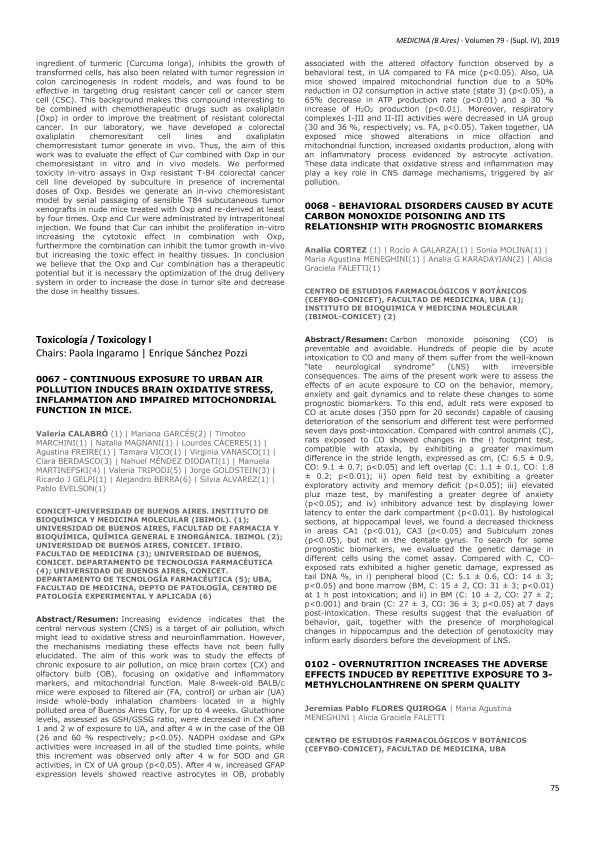Evento
Behavioral Disorders Caused by Acute Carbon Monoxide Poisoning and Its Relationship with Prognostic Biomarkers
Cortez, Analía Elizabeth; Galarza, Rocío Alejandra ; Molina, Sonia Jazmín
; Molina, Sonia Jazmín ; Meneghini, María Agustina
; Meneghini, María Agustina ; Karadayian, Analia Graciela
; Karadayian, Analia Graciela ; Faletti, Alicia Graciela
; Faletti, Alicia Graciela
 ; Molina, Sonia Jazmín
; Molina, Sonia Jazmín ; Meneghini, María Agustina
; Meneghini, María Agustina ; Karadayian, Analia Graciela
; Karadayian, Analia Graciela ; Faletti, Alicia Graciela
; Faletti, Alicia Graciela
Tipo del evento:
Reunión
Nombre del evento:
LXIV Reunión Anual de la Sociedad Argentina de Investigación Clínica; LI Reunión Anual de la Asociación Argentina de Farmacología Experimental; XXI Reunión Anual de la Sociedad Argentina de Biología; XXXI Reunión Anual de la Sociedad Argentina de Protozoología; IX Reunión Anual de la Asociación Argentina de Nanomedicinas y VI Reunión Científica Regional de la Asociación Argentina de Ciencia y Tecnología de Animales de Laboratorio
Fecha del evento:
13/11/2019
Institución Organizadora:
Sociedad Argentina de Investigación Clínica;
Asociación Argentina de Farmacología Experimental;
Sociedad Argentina de Biología;
Sociedad Argentina de Biología;
Asociación Argentina de Nanomedicinas;
Asociación Argentina de Ciencia y Tecnología de Animales de Laboratorio;
Título de la revista:
Medicina
Editorial:
Fundación Revista Medicina
ISSN:
0025-7680
Idioma:
Inglés
Clasificación temática:
Resumen
Carbon monoxide poisoning (CO) is preventable and avoidable. Hundreds ofpeople die by acute intoxication to CO, and many of them suffer the so-calledlate neurological syndrome (LNS) with irreversible consequences. The aims ofthe present work were to assess the effects of an acute exposure to CO on thebehavior, memory, anxiety, and gait dynamics and to relate these changes tosome prognostic biomarkers. To this end, adult rats were exposed to CO atacute doses (350 ppm for 20 seconds) capable of causing deterioration of thesensorium, and different tests were performed seven days post-intoxication.Compared with control animals (C), rats exposed to CO showed changes inthe (i) footprint test expressed as cm (C: 6.5±0.9; CO: 9.1±0.7; P<0.05) and leftoverlap (C: 1.1±0.1; CO: 1.8±0.2; P<0.01), compatible with ataxia by exhibiting agreater maximum difference in the stride length; (ii) open field test by exhibiting a greater exploratory activity and memory deficit (P<0.05); (iii) elevated pluzmaze test by manifesting a greater degree of anxiety (P<0.05); and (iv) inhibitory advance test by displaying a lower latency to enter the dark compartment(P<0.01). In order to search for some prognostic biomarkers, we evaluated thegenetic damage in different cells using the comet assay. Compared with C, COexposed rats exhibited a higher genetic damage, expressed as TailDNA%, in (i)peripheral blood (PB, CO: 14±3; C: 5,1±0,6; p<0.05) and bone marrow (BM, CO:31±3; C: 15±2; p<0.01) at 1 h post intoxication; and (ii) BM (CO: 27±2; C 10±2;p<0.001) and brain (B, CO: 36±3, C: 27±3, p<0.05) at 7 days post-intoxication.These results suggest that the behavioral evaluation, gait, and detection ofgenotoxicity may inform early disorders prior to the development of the LNS.
Palabras clave:
CARBON MONOXIDE
,
BEHAVIOR
,
POISONING
,
PROGNOSTIC
Archivos asociados
Licencia
Identificadores
Colecciones
Eventos(CEFYBO)
Eventos de CENTRO DE ESTUDIOS FARMACOLOGICOS Y BOTANICOS
Eventos de CENTRO DE ESTUDIOS FARMACOLOGICOS Y BOTANICOS
Eventos(IBIMOL)
Eventos de INSTITUTO DE BIOQUIMICA Y MEDICINA MOLECULAR
Eventos de INSTITUTO DE BIOQUIMICA Y MEDICINA MOLECULAR
Citación
Behavioral Disorders Caused by Acute Carbon Monoxide Poisoning and Its Relationship with Prognostic Biomarkers; LXIV Reunión Anual de la Sociedad Argentina de Investigación Clínica; LI Reunión Anual de la Asociación Argentina de Farmacología Experimental; XXI Reunión Anual de la Sociedad Argentina de Biología; XXXI Reunión Anual de la Sociedad Argentina de Protozoología; IX Reunión Anual de la Asociación Argentina de Nanomedicinas y VI Reunión Científica Regional de la Asociación Argentina de Ciencia y Tecnología de Animales de Laboratorio; Argentina; 2019; 1-1
Compartir



